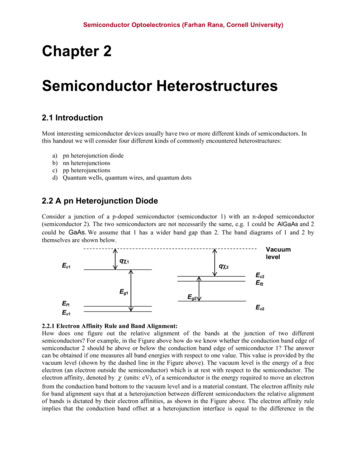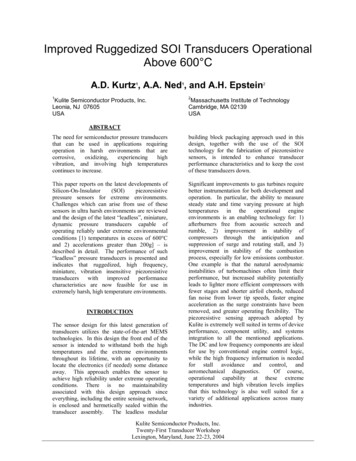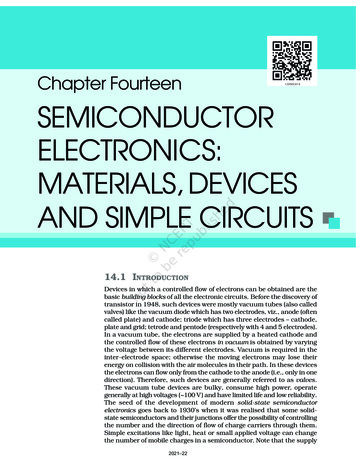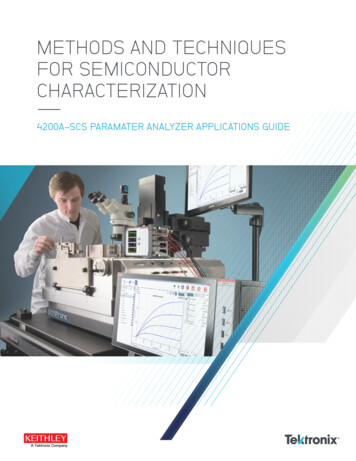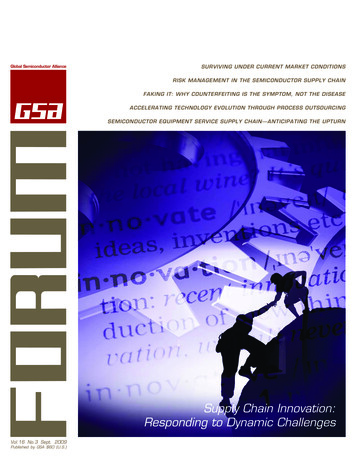
Transcription
Global Semiconductor AllianceSURVIVING UNDER CURRENT MARKET CONDITIONSRISK MANAGEMENT IN THE SEMICONDUCTOR SUPPLY CHAINFAKING IT: WHY COUNTERFEITING IS THE SYMPTOM, NOT THE DISEASEACCELERATING TECHNOLOGY EVOLUTION THROUGH PROCESS OUTSOURCINGSEMICONDUCTOR EQUIPMENT SERVICE SUPPLY CHAIN—ANTICIPATING THE UPTURNSupply Chain Innovation:Responding to Dynamic ChallengesVol.16 No.3 Sept. 2009Published by GSA 60 (U.S.)1
A Powerful Platform for Amazing PerformancePerformance. To get it right, you need a foundry with an Open Innovation Platform and process technologies thatprovides the flexibility to expertly choreograph your success. To get it right, you need TSMC.Whether your designs are built on mainstream or highly advanced processes, TSMC ensures your products achievemaximum value and performance.Product Differentiation. Increased functionality and better system performance drive product value. So you needa foundry partner who keeps your products at their innovative best. TSMC’s robust platform provides the options youneed to increase functionality, maximize system performance and ultimately differentiate your products.Faster Time-to-Market. Early market entry means more product revenue. TSMC’s DFM-driven design initiatives,libraries and IP programs, together with leading EDA suppliers and manufacturing data-driven PDKs, shorten your yieldramp. That gets you to market in a fraction of the time it takes your competition.Investment Optimization. Every design is an investment. Function integration and die size reduction help drive yourmargins. It’s simple, but not easy. We continuously improve our process technologies so you get your designs producedright the first time. Because that’s what it takes to choreograph a technical and business success.Find out how TSMC can drive your most important innovations with a powerful platform to create amazing performance.Visit www.tsmc.comCopyright 2008 Taiwan Semiconductor Manufacturing Company Ltd. All rights reserved. Open Innovation Platform is a trademark of TSMC.
ARTICLESCONTENTS2 Surviving under Current Market ConditionsRon Das, President and Chief Executive Officer, Siliconaire Inc.6 Risk Management in the Semiconductor Supply ChainACCELERATE THEGROWTH ANDSanthosh Kumar M, Client Partner, Bristlecone Inc.10 Faking It: Why Counterfeiting is the Symptom, Not the DiseaseFrank Cavallaro, Chief Executive Officer, Converge14 Accelerating Technology Evolution through Process OutsourcingINCREASE THERETURN ONINVESTED CAPITALJim Mello, Vice President, Sales and Marketing, Entrepix Inc.18 Semiconductor Equipment Service Supply Chain—Anticipating the UpturnJohn Nunes, Vice President, Strategic Consulting, MCA Solutions Inc.22 Improving ASIC Design Schedule EstimatesBob Eisenstadt, Principal Engineer, Alchip Technologies Inc.Jim Bailey, Chief Operating Officer, Alchip Technologies Inc.26 Axing the Hockey StickOF THE GLOBALSEMICONDUCTORINDUSTRY BYFOSTERING A MOREEFFECTIVE FABLESSJohn La Bouff, Senior Manager, Deloitte Consulting LLP30 Hardware Intrinsic Security: Better Security, Lower Cost and Faster Time-toMarketECOSYSTEMTHROUGHPim Tuyls, Chief Technology Officer and Founder, Intrinsic-IDMichael Buehler-Garcia, Director, Marketing, Calibre Design Solutions, Mentor Graphics Corp.34 Test Chip Collaboration Validates That Virtually Maskless SOCs Are Now PracticalAki Fujimura, Chief Executive Officer, D2S Inc., Managing Sponsor of the eBeam InitiativeMoazzem Hossain, Chief Executive Officer, Fastrack Design, Member of the eBeam InitiativeBob Smith, Vice President, Marketing, Magma Design Automation, Member of the eBeam InitiativeCOLLABORATION,INTEGRATION ANDINNOVATION. 36 Part 2 of 4: Bankruptcy: Crisis for Some, Opportunity for OthersAddress thechallenges andMichael Cooley, Partner, Gardere Wynne Sewell LLPenable industry-widesolutions withinthe supply chain,including intellectualIN EVERY ISSUEproperty (IP),electronic design4 Semiconductor Member Newsautomation8 Foundry Focus(EDA)/design, wafermanufacturing, test12 Back-End Alleyand packaging16 Supply Chain Chronicles20 Global Market Trends for meaningful24 Industry Reflections28 Global InsightsProvide a platformglobal collaboration Identify andarticulate market38 Private Showingopportunities39 Innovator Spotlight Encourageand supportentrepreneurshipINTERESTED IN CONTRIBUTING TO THE GSA FORUM?To contribute an article or submit product or company announcements, contact: Chelsea Boone, Managing Editor,cboone@gsaglobal.org. To advertise, contact: Monica Dominguez, Advertising Executive, mdominguez@gsaglobal.org. Provide memberswith comprehensiveF O R M O R E I N F O R M AT I O N C O N TA C TLisa Tafoya, VP, Global Research, GSA Forum Executive Editor, ltafoya@gsaglobal.org GSA 12400 Coit Road, Suite 650, Dallas, TX 75251 phone 888.322.5195 fax 972.239.2292and unique marketintelligenceM I S S I O N A N D V I S I O N S TAT E M E N T32 DFM: Coming into Its Own
Surviving under Current Market ConditionsRon Das, President and Chief Executive Officer, Siliconaire Inc.he unique strategy of outsourcing—the act of engaging externalresources to accomplish certain goals—has been increasinglyused by managers of successful corporations. There are twoscenarios that push companies towards outsourcing. First, as anindustry matures, there is the natural growth of a support ecosystem,and product manufacturers depend more and more on this ecosystemto stay competitive. Secondly, companies tend to build their internalresources at a rapid pace during strong business growth, and thengo through the unwanted and painful process of reduction in forceduring slow times.The semiconductor industry has seen these two scenarios play outover the last three decades, further contributing to the maturationprocess. It has experienced exuberant growth of the worldwide“supplier” ecosystem. By establishing themselves as strong corecompetency centers, suppliers have enforced an increasing dependenceof the product supplier on this ecosystem. The semiconductorindustry has also gone through several economic cycles of successiveboom and bust. All these events have made semiconductor companiesmore dependent on outsourcing for critical resources and corecompetencies.Each economic slowdown has opened the door for a new, criticalpart of the business process to be outsourced by semiconductorcompanies. It first started with integrated, vertical companies havingeverything under one roof. During the first major downturn, thenotion of outsourcing wafer processing to a pure-play foundry toaugment capacity took shape. Even industry leaders who publiclyproclaimed “real men have fabs” started using foundries to managethe cyclical nature of their business. It is easy to forget howresistant the industry was to outsourcing the most critical step inmanufacturing—wafer processing. But in time, newly establishedsemiconductor companies did not even plan to build or own anyfabs, thus giving birth to the fabless era.The development of electronic design automation (EDA) toolsthen gave rise to a new group of design service companies. Initially,semiconductor companies outsourced only segments of their designflow activities such as place and routing. But during the nextdownturn, design service companies became an integral part ofsemiconductor companies’ product design flows, and, eventually,critical intellectual property (IP) and block design activities wereoutsourced.Some current-generation fabless companies have startedoutsourcing the entire process: design, productization andmanufacturing. These companies market their products and holdownership of their products’ IP, and the actual design and manufactureof product is outsourced. However, many executives are still reluctanttowards outsourcing for fear they will lose control if they do not keepthese operations in-house.Business dynamics in the fabless sector have changed drasticallyin recent years and have become even more daunting during thecurrent economic downturn. Gone are the days when the venturecapital community created strong investment momentum forsemiconductor start-ups and the rate of initial public offerings(IPOs) was high, giving investors excellent returns. Now, investmentin semiconductor start-ups is much more limited, and marketenvironments are not encouraging to IPOs. Most of the recent exitshave been via acquisitions/mergers.In this business environment, it is extremely critical to keepfixed costs low and use variable cost structures wherever possible—especially for functions that do not directly contribute to a company’score competency. It is important to understand that similar to theindustry’s adaptation of the fabless business model, which allowedcompanies to become more cost-effective and competitive duringprevious downturns, a similar adaptation of an extreme fablessbusiness model (without a fab and a full in-house operation team)would make companies even more cost-effective and competitiveduring the current downturn.T2
During the early stages of product development, operationspersonnel are not fully utilized, yet their expertise and experience areneeded in making critical product planning and product definitiondecisions. Even during productization (post-design) the utilizationof these personnel is low. Only after the product is successfullylaunched into high-volume manufacturing are operations personnelfully utilized. Many companies carry a fixed cost structure for a longperiod of time by building an in-house operations team, and add totheir burn rate before getting actual market traction. This situationis not deemed suitable for the current environment wherein themost likely exit strategy is via an acquisition/merger. In most cases,operations personnel are stripped following an acquisition/merger asthey do not contribute to the acquiring company’s core competency.The sentiment of losing control when outsourcing productdevelopment and manufacturing should be examined in the samelight as past sentiments held about foundries. The adaptation of thefoundry by a semiconductor company was one of the most importantturning points in the industry. It allowed for the proliferation ofsolution providers without having to carry the enormous financialburden of owning a fab. The continuous growth of the semiconductorindustry over the last two decades would not have been possiblewithout foundries. There are several hundred fabless companiesworldwide supported by only a few foundries, thereby making it anextremely efficient and successful business model.Outsourcing packaging and testing services, as well as importantservices provided by analytical labs, is now standard. The outsourcingtrend can also extend to outsourcing product development andmanufacturing to an external “operations contractor” who deliversa company’s products by leveraging the supplier world. The rightoperations contractor can reduce costs and increase a semiconductorcompany’s chance of success.A new business model is now emerging in which a semiconductoroperations contractor offers the same services using a customerowned tooling (COT) approach wherein semiconductor customerscan procure their products at the raw cost of manufacturing. Thecontractor is paid a service fee for managing product developmentand manufacturing. The fee is much lower than it would be ifdevelopment and manufacturing was managed with internal resourcebuild-up. This is particularly more cost-effective in the early stagesof a start-up or in the early stages of product development at a moreestablished company. Furthermore, companies can preserve themargins they demand in the markets they serve.This new approach seems to be in demand during this periodof economic slowdown as it allows semiconductor companies tocontinue to do their product development at a much lower cost andkeep it variable at the same time. It is also the desirable strategy for apotential acquisition/merger when economic conditions improve.ConclusionIn summary, every economic downturn which has affected thesemiconductor industry has given legitimacy to a new sector ofservices to be outsourced. The outsourcing of these services thengradually becomes the norm for semiconductor companies to remaincost-effective and competitive, and, in turn, feeds the sustainedgrowth of the industry.The current downturn has necessitated a serious look at outsourcingproduct development and manufacturing to an operations contractor.A COT-based outsourced model is preferred over the ASIC modelfor obvious financial reasons. A properly leveraged outsourcingoperations strategy can better prepare an emerging company for theinevitable up-turn, and thus make it more attractive for an eventualmerger/acquisition or IPO. Selection of an Operations ContractorAbout the AuthorRon has 25 years of experience in the semiconductor industry in productdevelopment and silicon operations with both established, large companies andfabless start-ups. Prior to founding Siliconaire Inc., Ron was vice president ofoperations at Atheros Communications, a leader in the wireless local area network(WLAN) market. Ron joined Atheros at a very early stage and built a operationstechnical capability, infrastructure and strong relationship with suppliers to takethe world’s first CMOS 802.11a radio frequency (RF) transceivers into highvolume manufacturing with perfect quality records. This helped in growing thecompany’s revenue rapidly from 0 to a 180 million per year run rate, leadingto a successful IPO.Before Atheros, Ron was vice president of operations at NewPortCommunications. As one of its first employees, Ron was responsible for developingthe successful OC-192 SONET products into manufacturing volumes, leadingto an acquisition of the company. Previously, Ron held director-level positionsat Cirrus Logic and AMD. At Cirrus, Ron managed two operations jointventures—one with IBM and the other with Lucent Technologies—amongvarious other foundries to support the company’s 0.5 – 1.0B revenue. At AMD,Ron was responsible for outsourced operations, including a venture with Fujitsusupporting 400 million in revenue. Ron was also one of the key contributors intransitioning AMD from Bipolar to CMOS by developing several generations ofproducts and technologies.Ron has been very active in fabless industry panels and conferences. Ron’sleadership was acknowledged by industry peers by electing him to serve as a Boardmember of the Fabless Semiconductor Association (now Global SemiconductorAlliance) during 2001–2004. He holds a Ph.D. in electrical engineering fromUniversity of California, Santa Barbara, California. You can reach Ron Das at408-524-2600.Outsourcing IC development and manufacturing to an operationscontractor is actually not new, as illustrated by the application-specificIC (ASIC) industry. The ASIC business model was designed to servethe systems industry. Systems companies build their system productsutilizing standard and custom ICs. As they tend to not have in-houseresources (as it is not their core competency), they outsource thedevelopment and manufacture of their custom ICs. Large integrateddevice manufacturers (IDMs) (e.g., Philips, STMicroelectronics,Fujitsu and IBM) offered these services as they had the developmentand manufacturing resources, and, more importantly, they had theirown fabs to fill. In the ASIC business model, a supplier sells ICs at aunit price that includes manufacturing costs as well as margins. Fromthe systems companies’ point of view, it is still cost-effective becausethey get their margins from the total systems they sell to their ownmarkets.The ASIC business model has now been applied to serve the fablessindustry. Fabless ASIC suppliers do not own fabs and apply the fablessbusiness model to provide ASIC services to fabless companies. Andsome new fabless companies have outsourced product developmentand manufacturing to fabless ASIC companies for the last few years.Mirroring their predecessors, these fabless ASIC companies alsosell units to their semiconductor customers at a price that includesmanufacturing costs and some margins. This is not the most costeffective option for the fabless customer as they themselves resell thesame product to their customers and must give a good portion oftheir own margin to its ASIC supplier.3
Actel (NASDAQ: ACTL) releasedits free Mixed-Signal Power Manager(MPM). A reference design and graphicaluser interface (GUI) tool included in therecently announced Fusion AdvancedDevelopment Kit, MPM enablesdesigners to control and reduce power atthe system level, offering wer supervision and managementcapabilities. This latest offering highlightsthe significant integration benefits ofActel’s Fusion device, the industry’s firstmixed-signal field-programmable gatearray (FPGA).Bringing its acclaimed 45nmtechnology to new high-volume processordesigns, Advanced Micro Devices(NYSE: AMD) released two new dual-coredesktop processors. Building on 10 yearsof AMD Athlon processor innovation,the new 45nm AMD Athlon II X2 250processor gives mainstream consumersexceptional performance, efficiency andvalue.Alereon demonstrated an AppleiPhone/iPod peripheral reference designbased on its new worldwide, low-power90nm-LP AL5301 chip built at Samsung’s12-inch wafer fabrication facility inKorea.Analog Devices (NYSE: ADI)introduced the industry’s smallest fourchannel digital isolators. Housed in a small5mm 6mm quarter-size small outlinepackage (QSOP), ADI’s ADuM744xdigital isolators can isolate four channelsof data and power while reducing boardspace up to 70 percent and cutting costsby 20 percent.Broadcom (NASDAQ: BRCM) willintroduce a new family of gigabit passiveoptical network (GPON) integratedaccess device (IAD) semiconductorsto telecommunications providers andoriginalequipmentmanufacturers(OEMs) in China this year. The BroadcomBCM6800 family of GPON gatewayprocessors is designed to enable morecost-effective optical network terminals(ONTs) or optical network units (ONUs)used in conjunction with service providernetworks.BroadLogic Network Technologiesreleased the TeraQAM BL85000, theindustry’s first ultra-dense quadratureamplitude modulation (QAM) chip forsystems that transport video, voice anddata signals. It enables cable operators torespond efficiently and cost effectively tothe growing consumer demand for “anycontent, anytime” viewing by deliveringmore narrowcast and unicast services.CaliforniaMicroDevices(NASDAQ: CAMD) introduced theCM1624, an application-specific microSecure Digital (microSD) interfaceprotection filter for mobile andcomputing devices. The popular microSDFlash memory card is increasingly used inportable devices to allow users to store oruse data across different devices.The Emergent Network TechnologyTestbed group at the National Aeronauticsand Space Administration (NASA) AmesResearch Center is utilizing cPacket’scTap intelligent network taps for wirespeed monitoring of NASA links up to10 gigabits per second. cTaps provide thegroup with real-time situational awarenessof network behavior and traffic, as wellas a wide variety of troubleshootingand analysis capabilities not previouslyavailable at these data rates.Dialog Semiconductor (FWB: DLG)and TridonicAtco established a jointdevelopment center for next-generation,energy-efficient lighting technology.The move intensifies the longstandingsuccessful collaboration between thetwo companies in the developmentof ICs, such as the recently launchedTridonicAtco XITEC chip family.DSP Group (NASDAQ: DSPG)released its new Digital EnhancedCordless Telecommunications/CordlessAdvanced Technology-Internet andQuality (DECT/CAT-iq) module. Alow-cost, small form factor connectivityplatform, the DECT/CAT-iq moduledelivers superior coverage and widebandaudio (high-definition (HD) voice).Enpirion released two featurerich voltage mode synchronous buckdirect current-direct current (DC-DC)converters, the 6A EN5364 and 9AEN5394. These low-power switch-modeconverters are complete power systemson-chip (SOCs), achieving up to 93percent efficiency and integrating theinductor, power switches, gate drive,controller and loop compensation all intiny 8mm x 11mm x 1.85mm packages.EntropicCommunications’(NASDAQ: ENTR) RF4400 AdvancedTelevision Systems Committee (ATSC)silicon tuner has been selected by EchoStarTechnologies for its HD over-the-air(OTA) module for select HD set-topboxes. The RF4400 is an advanced silicontuner that provides high performance in asmall form factor.Exar (NASDAQ: EXAR) introducedthe industry’s fastest full-speed UniversalSerial Bus (USB) universal asynchronousreceiver/transmitter (UART) with upto 12Mbps serial data rate. The seriesis composed of three devices andcompliant to the USB 2.0 specification.The XR21V1410/V1412/V1414 havedifferentiated features which include thesmallest packaging options and optimizedsoftware drivers, and support large first in,first out (FIFO) sizes delivering flexibleand proven design options to systemarchitects.Fresco Microchip added FM1050,aworldwidelegacyaudio/videodemodulator for cable and terrestrialbroadcast television reception to its4line of breakthrough solutions. Thenew FM1050 provides optimumflexibility with universal support forNational Television System Committee(NTSC), Phase Alternating Line (PAL)and Sequential Color with Memory(SECAM) analog broadcast standards.The new demodulator addresses thestrong demand for analog-only televisionin Asia, including China and India, aswell as many parts of Eastern Europe.Leveraging its high-speed serialinterface and digital systems expertise,Gennum’s (TSX: GND) Snowbushintellectual property (IP) group hasdeveloped the industry’s first availableintegrated PCI Express (PCIe) 3.0physical layer (PHY) and controller IPsolution. The new PCIe 3.0 cores can belicensed immediately by SOC and systemcompanies, enabling early deploymentof PCIe 3.0 in systems requiring the 8.0GT/s performance of this new PeripheralComponent Interconnect-Special InterestGroup (PCI-SIG) standard.One of Himax Technologies’(NASDAQ: HIMX) liquid-crystal-onsilicon (LCOS) microdisplays, HX7027,received the 2009 Outstanding PhotonicsProduct Award by the Photonics Industryand Technology Development Association(PIDA). The HX7027 is a color-filterLCOS microdisplay with video graphicsarray (VGA) resolution (640x480)developed by Himax Display.IBM (NYSE: IBM) introduced newsystems software for managing virtualizedservers, designed to help clients plan, buildand maintain data centers while reducingcosts. IBM is also helping clients protecttheir long-term investments in PowerSystems by announcing an upgradedpath to its next-generation servers thatwill include POWER7 microprocessors.Intel (NASDAQ: INTC) is movingto a more advanced 34nm manufacturingprocess for its leading NAND Flash-basedsolid state drive (SSD) products, whichare an alternative to a computer’s harddrive. The move to 34nm will help lowerprices of the SSDs by up to 60 percentfor PC and laptop makers and consumerswho buy them due to the reduced die sizeand advanced engineering design.Jennic released a demonstrationplatform that successfully harveststhermal, solar, radio frequency (RF)and vibrational energy to power wirelesssensor networks based on the Instituteof Electrical and Electronics Engineers(IEEE) 802.15.4 standard such as ZigBeePRO and 6LoWPAN. The platformdemonstrates how wireless sensornetworks based on the IEEE802.15.4standard can eliminate the potentialmaintenance overheads of conventionalbattery power by harvesting energy fromsustainable sources.Key ASIC now offers IBM’ssemiconductor technology to its
customers. As a part of the relationship withIBM, Key ASIC will sell IBM-produced wafers,which contain design content and services fromKey ASIC, to its customers.L-3 Communications, Infrared Productslaunched its much-anticipated Thermal-Eye Renegade-320 thermal imaging system, theideal multi-use tool for force protection, borderpatrol officers, law enforcement professionals,special weapons and tactics (SWAT) units, andspecial operations forces. The Thermal-Eye Renegade-320 is designed for the operator thatneeds a single thermal imaging device that canmulti-task as a handheld, a tripod-mountedsurveillance system and a thermal weapon sight.LSI (NYSE: LSI) released real-time, ondemand multimedia transcoding software forthe award-winning family of LSITM StarPro multicore media processors that enables flexible,cost-effective solutions for any-to-any videocommunications and real-time collaborationthrough next-generation media gateways.MagnaChip Semiconductor released twonew light-emitting diode (LED) driver modelsfor constant current-based portable applications,the MAP1040 and MAP1042. In the wake ofits first launch of LED drivers for portableapplications, MagnaChip plans to reinforce itspresence in the power semiconductor market byfurther expanding to the LED driver markets fornotebooks and TVs down the road. The newlylaunched models can drive up to four LEDsfor displays on portable applications with onlyone LED driver, and MAP1042 has a strongerpower control function with a dual low-dropoutregulator (LDO) built in than the other model.Micronas (SWX: MASN) launched the newHAL 36xy family with its HAL 3625 Hall-effectsensor based on Micronas’ 3D-Hall technologyand equipped with vertical Hall elements. Thistechnology allows rotation angles from 0 to360 to be detected directly with minimummeasuring efforts.Microsemi (NASDAQ: MSCC) introduceda new line of standard rectifier diode powermodules with 21 standard dual-diode modulesand six three-phase bridge rectifier diode powermodules for industrial, uninterruptible powersupply (UPS), switched-mode power supply(SMPS) and motor drive applications. The newstandard rectifier diode modules are rated at1600 volts with a low forward voltage rating.NEC Electronics (TSE: 6723) successfullydeveloped new architecture that provides bothminiaturization and high accuracy to analogcircuits, including analog-to-digital (AD) anddigital-to-analog (DA) converters. To achieveminiaturization and high accuracy in analogcircuits, NEC Electronics’ new architecturepossesses a folding technique and a built-in selfcalibrating feature that can realize high-accuracyprocessing of the analog signals.ON Semiconductor (NASDAQ: ONNN)introduced the NCP5680 supercapacitoroptimized LED flash driver, which is capableof delivering up to 10 amperes for photo flashand video light in ultra-slim camera phones andcompact digital cameras.PLX Technology (NASDAQ: PLXT)sampled four of its newest high-performancePCIe switches that target the server, enterprisestorage, control plane and high-end gamingmarkets. These devices include the highest PCIeswitch lane counts in the industry at 96 and 80lanes.Powervation released the PV3002, thecompany’s inaugural product and the industry’sfirst Auto-control digital power conversionIC. The new chip is aimed at electronic systemsused in computing, netcomms and storageapplications where it brings fully automaticadaptive control to DC-DC conversion for thefirst time.Qualcomm(NASDAQ:QCOM)introduced the WCN1312 , a single-chip, highperformance, 802.11n-compliant wireless localarea networking (WLAN) solution for handsetsand mobile devices. This highly integrated devicesupports data rates of up to 72Mbps, which issignificantly higher than previous 802.11a, b andg Wi-Fi solutions, for a better user experiencewhen downloading data, watching streamingvideo or surfing the Internet.Redpine Signals and Ascom WirelessSolutions partnered to create next-generationvoice-over-Wi-Fi (VoWiFi) phones with802.11n wireless connectivity. The new VoWiFiphone designs are built upon Ascom’s longexperience of offering state-of-the-art purposebuilt handsets, wireless voice and messagetransmission systems, and customized alarm andpositioning applications.RF Micro Devices (NASDAQ: RFMD)entered into a cooperative agreement withthe U.S. Department of Energy’s NationalRenewable Energy Laboratory (NREL) todevelop a commercially viable and high volumecapable compound semiconductor-based processfor high-performance photovoltaic (PV) cells.SanDisk (NASDAQ: SNDK) introducedthe fastest 32GB Secure Digital High Capacity(SDHC ) card on the market. The 32GBSanDisk Extreme SDHC card at up to 30MB/sread and write speeds combines industry-leadingperformance with massive storage capacity,helping digital photography enthusiasts utilizethe advanced features of today’s digital singlelens reflex (DSLR) cameras.Skyworks Solutions (NASDAQ: SWKS)partnered with several of the energy industry’stop solution providers to meet the growingworldwide demand for smart water, gas andelectric meter readers. These strategic partnershipsenable Skyworks to develop and ramp low-costsolutions for remote meter reading applicationsand smart grid technologies.StandardMicrosystems(NASDAQ:SMSC) released the OS85650 input/output(I/O) companion chip for MOST intelligentnetwork interface controllers (INICs). With itsmultiple interfaces, powerful routing engine andthe Digital Transmission Content Protection(DTCP) co-processor, the OS85650 can be usedfor various audio and video applications such ashead units, rear seat entertainment, amplifiers,TV tuners and video displays.Summit Microelectronics introducedtwo more members of its third-generationprogrammable battery charger IC family. TheSMB136 and SMB137B employ CurrentPath5technology, providing dual input source (USBor AC/DC) with arbitration, dual output forsystem and battery, and system operation with adead or missing battery.Teradici launched a comprehensive newpartner program for value-added resellers (VARs),system integrators (SIs) and OEMs who want todeliver superior remote computing and virtualdesktop solutions to their customers. The newPC-over-IP (PCoIP) partner program providesVARs, SIs and OEMs with everything theyneed to sell and deploy PCoIP-based solutions,including product education, marketingcollateral, competitive information, sales leads,product discounts, and both m
risk management in the semiconductor supply chain faking it: why counterfeiting is the symptom, not the disease accelerating technology evolution through process outsourcing semiconductor equipment service supply chain—anticipating the upturn global semiconductor alliance vol.16 no.3 sept. 2009 published by gsa 60 (u.s.) supply chain innovation:


